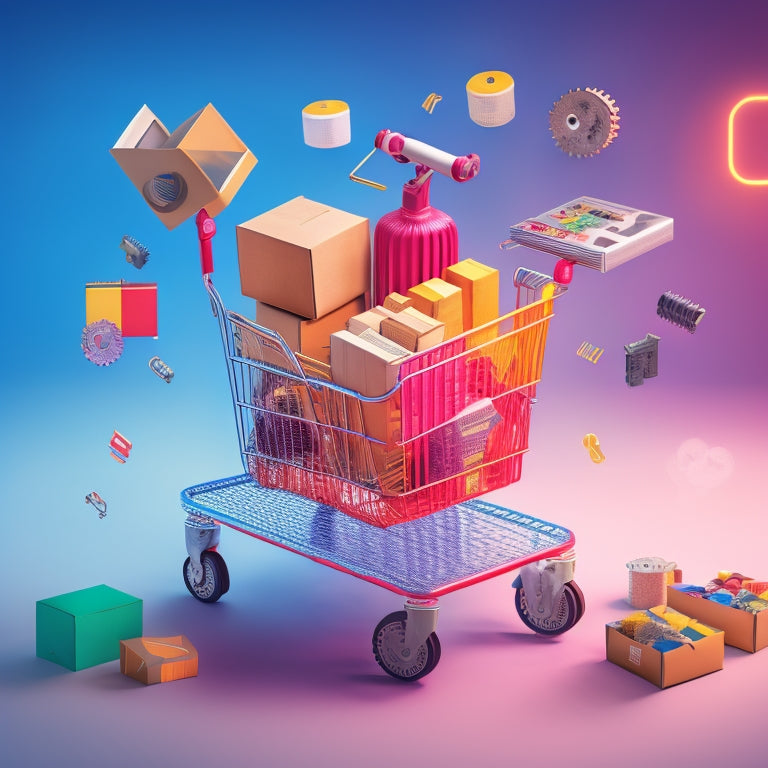
What Tasks Can You Automate in Ecommerce Support?
Share
You can automate various tasks in ecommerce support to free up your team's time and improve customer satisfaction. For instance, you can automate handling order status updates, out-of-stock notifications, and order tracking updates. You can also automate customer service tasks like product return requests, answering product information queries, and processing refund and exchange requests. Additionally, you can automate resolving shipping issues quickly, dealing with payment problems, and addressing common customer complaints. By automating these tasks, you'll not only improve efficiency but also reduce the risk of fraudulent transactions - and that's just the beginning of what you can achieve.
Key Takeaways
• Automate product return requests to reduce manual effort and improve customer satisfaction.
• Handle order status updates and automated status updates to keep customers informed and reduce inquiries.
• Respond to cancellation requests and provide order tracking updates to ensure timely communication.
• Automate return processes and manage out-of-stock notifications to streamline operations and reduce support tickets.
• Resolve shipping issues quickly and deal with payment issues efficiently to minimize customer frustration.
Automating Product Return Requests
Implementing an automated product return request system streamlines the process, allowing customers to initiate returns quickly and efficiently, while also reducing the workload of your support team. By automating this task, you're improving customer experience by providing them with a hassle-free return process. This, in turn, enhances their overall satisfaction with your brand.
With an automated system, customers can easily initiate returns, track their status, and receive updates - all without needing to contact your support team.
This automation also enables you to enhance efficiency in returns. You can set up a system that automatically generates return shipping labels, sends notifications, and updates inventory levels. This reduces the manual workload of your support team, freeing them up to focus on more complex issues that require human intervention.
Handling Order Status Updates
When you automate order status updates, you'll need to decide how to keep customers informed about their orders' progress.
You'll want to set up a system that sends timely notifications, such as 'order shipped' or 'order delayed,' to manage customer expectations.
Order Status Notifications
You can set up automated order status notifications to keep customers informed about their order's progress, from processing and shipping to delivery and completion. This not only enhances customer satisfaction but also reduces the number of 'where is my order?' queries, freeing up your support team to focus on more intricate issues.
By automating order status notifications, you can guarantee that customers receive timely updates, reducing anxiety and uncertainty.
Automated notifications also improve communication efficiency by eliminating the need for manual updates. You can personalize notifications to match your brand's voice and style, ensuring a uniform customer experience. For example, you can send notifications when an order is processed, shipped, or delivered, providing customers with real-time updates.
Furthermore, you can include tracking information, enabling customers to monitor their order's progress. By automating order status notifications, you can offer a smooth and transparent experience, leading to increased customer loyalty and retention.
Automated Status Updates
By automating status updates, your ecommerce support team can efficiently handle order status updates, ensuring that customers receive accurate and timely information about their orders. This not only reduces the workload of your support team but also enhances the overall customer experience.
With automated status updates, you can:
- Trigger updates based on specific events, such as shipment or delivery
- Send personalized notifications with order details and tracking information
- Reduce the number of support requests and inquiries about order status
Moreover, automated status updates can be integrated with other automation tools, such as AI chatbots for support, to provide a seamless customer experience. For instance, if a customer inquires about their order status, the chatbot can provide an instant update, eliminating the need for human intervention.
Additionally, automated customer surveys can be sent after order completion to gather feedback and improve future orders. By automating status updates, you can free up your support team to focus on more complex issues and provide exceptional customer service.
Resolving Shipping Issues Quickly
Fast-track shipping issue resolution by empowering customer support agents to quickly verify order details and pinpoint delays. This enables them to provide timely shipping delay solutions, ensuring customer satisfaction strategies are executed effectively.
By automating the verification process, agents can focus on resolving issues rather than spending time gathering information.
When a customer reports a shipping issue, your automated system can immediately retrieve the order details, including the tracking number. This allows agents to quickly identify the cause of the delay and offer expedited delivery options to rectify the situation.
With automated tracking number assistance, agents can provide real-time updates to customers, keeping them informed and reducing frustration.
Answering Product Information Queries
Instant access to accurate product information enables your customer support agents to quickly respond to customer inquiries, reducing wait times and resolution delays. By automating the process of answering product information queries, you can greatly improve response time and enhance customer experience.
This is especially important for ecommerce businesses, where customers often have questions about product features, availability, and compatibility.
To automate this process, you can implement a knowledge base or FAQ section on your website, where customers can easily find answers to common product-related questions. Additionally, you can:
-
Use chatbots to provide instant responses to customer inquiries
-
Implement a product information database that customer support agents can access quickly
-
Create a system for customers to submit product-related questions and receive automated responses
Processing Refund and Exchange Requests
When handling refund and exchange requests, you'll need to clarify your refund policy to customers and analyze exchange requests to determine whether they meet your store's criteria.
By automating these tasks, you can reduce the workload on your support team and provide faster resolutions to customers.
In this section, we'll explore how to implement automation for refund policy clarification and exchange request analysis, ensuring a seamless experience for both your team and customers.
Refund Policy Clarification
You need to clarify your refund policy to customers, specifying the conditions under which refunds and exchanges are accepted and the procedures for requesting them. This guarantees transparency and sets clear expectations, reducing the likelihood of misunderstandings and disputes.
When it comes to refund processing, you can automate tasks such as:
Providing detailed return policy FAQs that outline the steps customers need to take to initiate a refund or exchange
Sending automated responses to customers who inquire about the refund process, including information on timelines and procedures
Updating order status and sending confirmation emails when a refund is processed
Exchange Request Analysis
Frequently, customers initiate exchange requests due to sizing issues, color discrepancies, or other product-related problems, and it's important to analyze these requests efficiently to guarantee timely resolutions.
By automating exchange request analysis, you can quickly identify the root causes of these issues and take corrective action. For instance, you can use automation to categorize exchange requests by reason, product, or customer segment, and then analyze these trends to identify areas for improvement. This helps you in analyzing return trends and optimizing return processes.
You can also automate the process of sending personalized responses to customers, providing them with clear instructions on how to proceed with their exchange requests. By automating these tasks, you can free up your customer support team to focus on higher-value tasks, such as resolving complex customer issues and providing proactive support.
With automated exchange request analysis, you can reduce the time and effort required to process exchanges, leading to faster resolutions and increased customer satisfaction.
Managing Out-of-Stock Notifications
Set up an automated system to notify customers of out-of-stock items, ensuring they're informed and reducing the likelihood of frustrated shoppers. This is especially important for ecommerce businesses that rely on timely deliveries and customer satisfaction.
By automating out-of-stock notifications, you can focus on inventory management and restocking strategies to minimize stockouts.
Here are some benefits of automating out-of-stock notifications:
-
Reduced cart abandonment: Customers are less likely to abandon their carts when they're informed about stock availability.
-
Improved customer experience: Automated alerts keep customers informed, reducing the likelihood of frustrated shoppers and negative reviews.
-
Increased efficiency: You'll save time and resources by automating notifications, allowing you to focus on more strategic tasks.
Responding to Cancellation Requests
About 20% of online shoppers cancel their orders, making it crucial to respond promptly to these requests and maintain a positive customer experience. You can't afford to let cancellation requests linger, causing frustration and potentially damaging your brand reputation.
By automating your response to cancellation requests, you can optimize the cancellation process and ensure a seamless experience for your customers.
Implementing automated response strategies can help you respond quickly and efficiently to cancellation requests. For instance, you can set up an automated email response that acknowledges the customer's request and provides a clear timeline for processing the cancellation. This not only saves you time but also establishes clear expectations for your customers.
Providing Order Tracking Updates
Keeping your customers informed about their order's status helps build trust and reduces anxiety, as they can plan accordingly and track their package's progress. By automating order tracking updates, you can make sure that customers receive timely and accurate information about their orders. This not only enhances customer engagement but also improves customer satisfaction.
You can automate order tracking updates by setting up a system that sends notifications at each stage of the delivery process. For example:
-
When the order is shipped, send a notification with the tracking number and estimated delivery date.
-
When the order is out for delivery, send a notification with a confirmation of the delivery date and time.
-
When the order is delivered, send a notification with a confirmation of delivery and a thank you message.
Dealing With Payment Issues Fast
When payment issues arise, you can quickly resolve them by implementing an automated system that detects and addresses problems in real-time, ensuring minimal disruption to the customer's shopping experience.
This automation can include payment processing automation, which helps to identify and rectify issues such as declined payments, failed transactions, and incorrect payment information.
Additionally, incorporating fraud prevention strategies into your automation system can help to minimize the risk of fraudulent transactions, reducing the need for manual intervention and increasing customer trust.
Addressing Common Customer Complaints
When you're automating ecommerce support, you'll want to focus on addressing the most common customer complaints that come up.
These typically revolve around resolving order issues, answering product info queries, and providing clear return policy guidance.
Resolving Order Issues
Frequently, customers reach out to ecommerce support teams to resolve issues with their orders, and addressing these concerns promptly is essential to maintaining a positive customer experience.
You can automate certain tasks to efficiently resolve order issues and improve customer satisfaction.
When a customer reports an issue with their order, you can trigger an automated workflow that:
-
Sends a confirmation email to the customer, acknowledging their concern and providing a ticket number for reference
-
Assigns the issue to a support agent, ensuring it's addressed promptly and efficiently
-
Initiates an escalation process if the issue remains unresolved after a specified time, ensuring that complex problems are routed to senior agents or specialized teams
Product Info Queries
Customers often bombard ecommerce support teams with questions about product features, availability, and compatibility, which can be efficiently addressed through automation. You can implement automated inventory updates to provide customers with real-time product availability, reducing the number of queries about stock levels. Additionally, product comparison tools can be integrated to help customers make informed purchasing decisions, minimizing the need for human intervention.
Here are some examples of product info queries that can be automated:
| Query Type | Automation Solution | Benefits |
|---|---|---|
| Product compatibility | Automated product matching | Reduced support queries, increased customer satisfaction |
| Product features | AI-powered product descriptions | Accurate, up-to-date product information, improved customer experience |
| Product availability | Automated inventory updates | Real-time stock levels, reduced support queries, improved customer satisfaction |
Return Policy Clarity
By implementing automation in product info queries, you've already taken a significant step in reducing support queries; now, it's time to tackle another common pain point: clarifying return policies to address customer complaints and reduce potential disputes.
Return policy clarity is pivotal in ecommerce support. When customers are unsure about the return process or refund eligibility, it can lead to frustration and disputes. By automating return policy clarification, you can reduce the number of support queries and provide a better customer experience.
Here are some ways to automate return policy clarity:
-
Return process simplification: Create a clear, step-by-step guide on how to initiate a return, including the required documents and timelines.
-
Refund eligibility clarification: Develop a system that automatically checks if a customer is eligible for a refund based on your store's return policy.
-
Automated return policy notifications: Set up a system that sends customers automated notifications about the return status, ensuring they're always informed about the progress.
Frequently Asked Questions
Can I Get a Discount on My First Purchase?
"As a first-time buyer, you're eligible for a 15% discount on your first purchase! Just use code NEWBIE15 at checkout. We also offer exclusive deals for new customers, so be sure to sign up for our newsletter for more perks!"
Do You Offer Gift Wrapping Services?
You're wondering if we offer gift wrapping services? Yes, we do! You can even add a personalized message. Plus, you'll receive automated notifications when it's processed and shipped, so you can stay on top of your gift-giving game.
Can I Use Multiple Promo Codes at Once?
You're the master of your shopping destiny, but sadly, you can't stack the deck with multiple promo codes at once; most ecommerce sites have promo code limitations to prevent discount overload, so you'll need to strategically choose one to maximize your savings.
Do You Have a Student Discount Program?
You're wondering if we have a student discount program? Yes, we do! You'll love our loyalty rewards and subscription discounts, designed to help students like you save big on our products and services.
Can I Purchase Gift Cards Online?
You're looking to spread some love with online gift cards! Yes, you can purchase them online and have them delivered instantly via email. You'll have various payment options to choose from, making it a seamless experience.
Related Posts
-
Leveraging The Best Shopify Instagram Apps
In the world of e-commerce, leveraging social media platforms like Instagram has become increasingly important for bu...
-

What Is the Best Instagram Feed App for Shopify
This article aims to provide an objective analysis of the best Instagram feed app for Shopify. By adhering to an aca...
-

Creating Product Bundles on Shopify: Simple Methods and Strategies
This article examines the process of creating product bundles on Shopify, focusing on simple methods and strategies....

